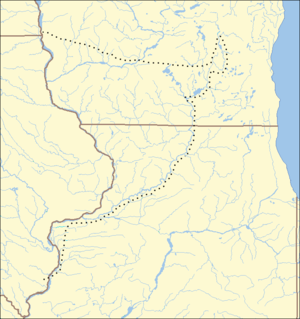Battle of Horseshoe Bend (1832)
| Battle of Horseshoe Bend | |||||||
|---|---|---|---|---|---|---|---|
| Part of the Black Hawk War | |||||||
 An 1857 painting of the battlefield at Horseshoe Bend. |
|||||||
|
|||||||
| Belligerents | |||||||
|
|
Kickapoo; loosely affiliated with Black Hawk's British Band | ||||||
| Commanders and leaders | |||||||
| Henry Dodge | |||||||
| Strength | |||||||
| 30 | 11 | ||||||
| Casualties and losses | |||||||
| 3 KIA 1 WIA |
11 KIA | ||||||
|
Pecatonica Battlefield
|
|
| Location | 2995 County Road Y |
|---|---|
| Nearest city | Woodford, Wisconsin |
| Coordinates | 42°39′40″N 89°52′40″W / 42.66111°N 89.87778°W |
| NRHP Reference # | 11000488 |
| Added to NRHP | July 28, 2011 |
The Battle of Horseshoe Bend, also referred to as the Battle of Pecatonica and the Battle of Bloody Lake, was fought on June 16, 1832 in present-day Wisconsin at an oxbow lake known as "Horseshoe Bend", which was formed by a change in course of the Pecatonica River. The battle was a major turning point in the Black Hawk War, despite being of only minor military significance. The small victory won by the U.S. militia at Horseshoe Bend helped restore public confidence in the volunteer force following an embarrassing defeat at Stillman's Run. The Battle of Horseshoe Bend ended with three militia men killed in action and a party of eleven Kickapoo warriors dead.
The militia men involved in the Battle of Horseshoe Bend proved their ability to obey orders, act as a disciplined unit, and show bravery. Unlike at Stillman's Run, the troops waited for Colonel Henry Dodge's commands before acting on the field of battle. When ordered to charge, the men obeyed and eventually won a fight that descended into a bloody hand-to-hand battle. A memorial marker was erected to commemorate the battle in 1922. Today the battleground at Horseshoe Bend is a county park.
As a consequence of an 1804 treaty between Governor William Henry Harrison of Indiana Territory and a group of Sauk and Fox leaders regarding land settlement, the Sauk and Fox tribes vacated their lands in Illinois and moved west of the Mississippi in 1828. However, Sauk Chief Black Hawk and others disputed the treaty, claiming that the full tribal councils had not been consulted, nor did those representing the tribes have authorization to cede lands. Angered by the loss of his birthplace, between 1830 and 1831 Black Hawk led a number of incursions across the Mississippi River, but was persuaded to return west each time without bloodshed. In April 1832, encouraged by promises of alliance with other tribes and the British, he again moved his so-called "British Band" of around 1000 warriors and non-combatants into Illinois. Finding no allies, he attempted to return to Iowa, but the undisciplined Illinois Militia force's actions led to the Battle of Stillman's Run. A number of other small skirmishes and massacres followed and the militias of Michigan Territory and Illinois were mobilized to hunt down Black Hawk's Band. The conflict became known as the Black Hawk War.
...
Wikipedia



